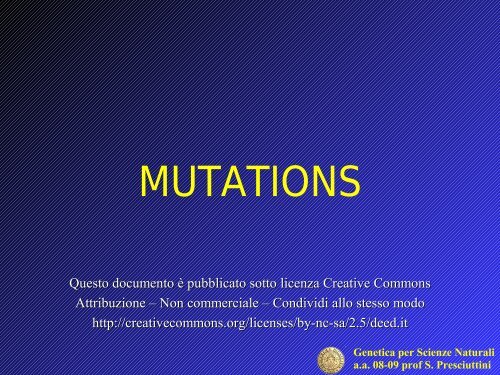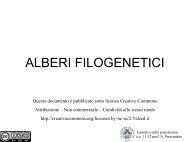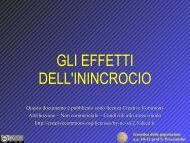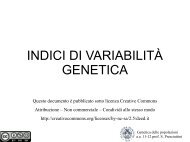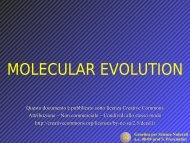Gene mutation
Gene mutation
Gene mutation
Create successful ePaper yourself
Turn your PDF publications into a flip-book with our unique Google optimized e-Paper software.
MUTATIONS<br />
Questo documento è pubblicato sotto licenza Creative Commons<br />
Attribuzione – Non commerciale – Condividi allo stesso modo<br />
http://creativecommons.org/licenses/by-nc-sa/2.5/deed.it<br />
<strong>Gene</strong>tica per Scienze Naturali<br />
a.a. 08-09 prof S. Presciuttini
<strong>Gene</strong>tic <strong>mutation</strong>s<br />
<br />
<br />
A <strong>mutation</strong> is a herita<br />
table<br />
change of the genetic material<br />
<strong>Gene</strong>ticists recognize three different levels at which <strong>mutation</strong> takes<br />
place.<br />
<br />
<br />
<br />
In gene <strong>mutation</strong>, , an allele of a gene changes, becoming a different allele.<br />
Because such a change takes place within a single gene and maps to one<br />
chromosomal locus ("point"), a gene <strong>mutation</strong> is sometimes called a point<br />
<strong>mutation</strong>.<br />
In chromosome <strong>mutation</strong>s, , the structure of one or more chromosome is altered.<br />
<strong>Gene</strong> <strong>mutation</strong> is not necessarily a part of such a process; the effects of<br />
chromosome <strong>mutation</strong> are due more to the new arrangement of chromosomes and<br />
of the genes that they contain. Nevertheless, some chromosome <strong>mutation</strong>s, in<br />
particular those proceeding from chromosome breaks, are accompanied by gene<br />
<strong>mutation</strong>s caused by the disruption at the breakpoint.<br />
In genome <strong>mutation</strong>s, , whole chromosomes, or even entire sets of chromosomes,<br />
change. Duplications of entire genomes in the course of evolution are particularly<br />
important as a mechanism resulting in sudden expansions in gene number<br />
<strong>Gene</strong>tica per Scienze Naturali<br />
a.a. 08-09 prof S. Presciuttini
Basic terminology about gene <strong>mutation</strong><br />
The ultimate source of genetic variation is gene <strong>mutation</strong><br />
To consider change, we must have a fixed reference point, or standard. In genetics,<br />
the wild type provides the standard (the wild-type allele may be either the form<br />
found in nature or the form found in a standard laboratory stock).<br />
Any change away from the wild-type allele is called forward <strong>mutation</strong>; any<br />
change back to the wild-type allele is called reverse <strong>mutation</strong>.<br />
The non-wild-type allele of a gene is often called a <strong>mutation</strong>. . To use the same word<br />
for the process and the product may seem confusing, but in practice little confusion<br />
arises.<br />
Thus, we can speak of a dominant <strong>mutation</strong> or a recessive <strong>mutation</strong>. Consider,<br />
however, how arbitrary these definitions are; the wild type of today may have been a<br />
<strong>mutation</strong> in the evolutionary past, and vice versa.<br />
Another useful term is mutant. . A mutant organism or cell is one whose changed<br />
phenotype is attributable to the possession of a <strong>mutation</strong>. Sometimes the noun is left<br />
unstated; in this case, a mutant always means an individual or cell with a phenotype<br />
that shows that it bears a <strong>mutation</strong>.<br />
Two other useful terms are <strong>mutation</strong> event, , which is the actual occurrence of a<br />
<strong>mutation</strong>, and <strong>mutation</strong> frequency, , the proportion of <strong>mutation</strong>s in a population of<br />
cells or individual organisms.<br />
<strong>Gene</strong>tica per Scienze Naturali<br />
a.a. 08-09 prof S. Presciuttini
Somatic <strong>mutation</strong>s<br />
A somatic <strong>mutation</strong> occurs in a single cell of developing somatic tissue in an<br />
individual organism; that cell may become the progenitor of a population of<br />
identical mutant cells, all of which have descended from the cell that mutated; ; this<br />
phenomenon is particularly important in cancer.<br />
A population of identical cells derived asexually from one progenitor cell is called a<br />
clone. . Because the members of a clone tend to stay close to one another during<br />
development, an observable outcome of a somatic <strong>mutation</strong> is often a patch of<br />
phenotypically mutant cells called a mutant sector. The earlier in development the<br />
<strong>mutation</strong> event, the larger the mutant sector will be.<br />
Somatic <strong>mutation</strong> in the red Delicious apple. The<br />
mutant allele determining the golden color arose in a<br />
flower's ovary wall, which eventually developed into<br />
the fleshy part of the apple. The seeds are not mutant<br />
and will give rise to red-appled trees. In n fact, the<br />
golden Delicious apple originally arose as a mutant<br />
branch on a red Delicious tree.<br />
<strong>Gene</strong>tica per Scienze Naturali<br />
a.a. 08-09 prof S. Presciuttini
Germinal <strong>mutation</strong>s<br />
Somatic <strong>mutation</strong>s are never n<br />
passed on to progeny.<br />
On the contrary, <strong>mutation</strong>s that occurs in the germ line, special tissue<br />
that is set aside in the course of development to form sex cells, will be<br />
passed on to the next generation. . These are called germinal<br />
<strong>mutation</strong>s.<br />
An individual of perfectly normal phenotype and of normal ancestry<br />
can harbor undetected mutant sex cells. These <strong>mutation</strong>s can be<br />
detected only if they are included in a zygote.<br />
<br />
For example, the t<br />
X-linked hemophilia <strong>mutation</strong> in European royal families is<br />
thought to have arisen in the germ cells of Queen Victoria or one of her parents.<br />
<strong>Gene</strong>tica per Scienze Naturali<br />
a.a. 08-09 prof S. Presciuttini
Hemophilia<br />
The original hemophilia <strong>mutation</strong> in the pedigree of the royal families of Europe arose<br />
in the reproductive cells of Queen Victoria's parents or of Queen Victoria herself.<br />
<strong>Gene</strong>tica per Scienze Naturali<br />
a.a. 08-09 prof S. Presciuttini
Point <strong>mutation</strong>s: base substitutions<br />
Point <strong>mutation</strong>s typically refer to alterations of single base pairs of<br />
DNA or of a small number of adjacent base pairs.<br />
At the DNA level, there are two main types of point <strong>mutation</strong>al<br />
changes: base substitutions and base additions or deletions.<br />
Base substitutions are those <strong>mutation</strong>s in which one base pair is<br />
replaced by another. Base substitutions again can be divided into two<br />
subtypes: transitions and transversions.<br />
Addition or deletion <strong>mutation</strong>s are actually of nucleotide pairs;<br />
nevertheless, the convention is to call them base-pair additions or<br />
deletions. The simplest of these <strong>mutation</strong>s are single-base-pair<br />
additions or single-base-pair deletions. <strong>Gene</strong> <strong>mutation</strong>s may arise<br />
through simultaneous addition or deletion of multiple base pairs at<br />
once.<br />
<strong>Gene</strong>tica per Scienze Naturali<br />
a.a. 08-09 prof S. Presciuttini
Functional consequences of base changes<br />
We first f<br />
consider what happens when a <strong>mutation</strong> arises in a polypeptide coding part<br />
of a gene. Depending on the consequences, single-base substitutions are classified<br />
into:<br />
Silent or synonymous <strong>mutation</strong>s: the <strong>mutation</strong> changes one codon for an amino acid<br />
into another codon for that same amino acid.<br />
Missense <strong>mutation</strong>s: the codon for one amino acid is replaced by a codon for another<br />
amino acid.<br />
Nonsense <strong>mutation</strong>s: the codon for one amino acid is replaced by a translation<br />
termination (stop) codon.<br />
The severity of the effect of missense and nonsense <strong>mutation</strong>s on the polypeptide<br />
may differ. If f a missense <strong>mutation</strong> causes the substitution of a chemically similar<br />
amino acid (conservative substitution),<br />
then it is likely that the alteration will have<br />
a less-severe effect on the protein's structure and function. Alternatively, chemically<br />
different amino acid substitutions, called nonconservative substitutions, are more<br />
likely to produce severe changes in protein structure and function.<br />
Nonsense <strong>mutation</strong>s will lead to the premature termination of translation. Thus, they<br />
have a considerable effect on protein function. Unless they occur very close to the<br />
3’ end of the open reading frame, so that only a partly functional truncated<br />
polypeptide is produced, nonsense <strong>mutation</strong>s will produce inactive protein products.<br />
<strong>Gene</strong>tica per Scienze Naturali<br />
a.a. 08-09 prof S. Presciuttini
Functional consequences of frameshift <strong>mutation</strong>s<br />
On the other hand, single-base additions or deletions have<br />
consequences on polypeptide sequence that extend far beyond the site<br />
of the <strong>mutation</strong> itself, like nonsense <strong>mutation</strong>s.<br />
Because the sequence of mRNA is "read" by the translational<br />
apparatus in groups of three base pairs (codons), the addition or<br />
deletion of a single base pair of DNA will change the reading frame<br />
starting from the location of the addition or deletion and extending<br />
through to the carboxy terminal of the protein. Hence, these lesions<br />
are called frameshift <strong>mutation</strong>s.<br />
These <strong>mutation</strong>s cause the entire amino acid sequence translationally<br />
downstream of the mutant site to bear no relation to the original<br />
amino acid sequence.<br />
Thus, frameshift <strong>mutation</strong>s typically exhibit complete loss of normal<br />
protein structure and function.<br />
<strong>Gene</strong>tica per Scienze Naturali<br />
a.a. 08-09 prof S. Presciuttini
Examples of point <strong>mutation</strong>s<br />
<strong>Gene</strong>tica per Scienze Naturali<br />
a.a. 08-09 prof S. Presciuttini
Mutations in non-coding regions<br />
Now let's turn to those <strong>mutation</strong>s that occur in regulatory and other non-coding<br />
sequences. Those parts of a gene that are not protein coding contain a variety of<br />
crucial functional sites. At the DNA level, there are sites to which specific<br />
transcription-regulating proteins must bind. At the RNA level, there are also<br />
important functional sequences such as the ribosome-binding sites of bacterial<br />
mRNAs and the self-ligating sites for intron excision in eukaryote mRNAs.<br />
The consequences of <strong>mutation</strong>s in parts of a gene other that the polypeptide-coding<br />
segments are difficult to predict. In general, the functional consequences of any<br />
point <strong>mutation</strong> (substitution or addition or deletion) in such a region depend on its<br />
location and on whether it disrupts a functional site. Mutations that disrupt these<br />
sites have the potential to change the expression pattern of a gene in terms of the<br />
amount of product expressed at a certain time or in response to certain<br />
environmental cues or in certain tissues.<br />
It is important to realize that such regulatory <strong>mutation</strong>s will affect the amount of the<br />
protein product of a gene, but they will not alter the structure of the protein.<br />
<strong>Gene</strong>tica per Scienze Naturali<br />
a.a. 08-09 prof S. Presciuttini
Mechanisms of Spontaneous Mutation<br />
The origin of spontaneous hereditary change has always been a topic<br />
of considerable interest. It is known now that spontaneous <strong>mutation</strong>s<br />
arise from a variety of sources, including errors in DNA replication,<br />
spontaneous lesions, and other more complex mechanisms.<br />
Spontaneous <strong>mutation</strong>s are very rare, making it difficult to determine<br />
the underlying mechanisms. How then do we have insight into the<br />
processes governing spontaneous <strong>mutation</strong>? Even though they are<br />
rare, some selective systems allow numerous spontaneous <strong>mutation</strong>s<br />
to be obtained and then characterized at the molecular level for<br />
example, their DNA sequences can be determined. From the nature of<br />
the sequence changes, inferences can be made about the processes that<br />
have led to the spontaneous <strong>mutation</strong>s.<br />
<strong>Gene</strong>tica per Scienze Naturali<br />
a.a. 08-09 prof S. Presciuttini
Errors in DNA replication<br />
Mispairing in the course of replication is a source of spontaneous base substitution.<br />
Tautomers of bases<br />
Each of the bases in DNA can appear in one of several forms, called tautomers,<br />
which are isomers that differ in the positions of their atoms and in the bonds<br />
between the atoms. The forms are in equilibrium. The keto form of each base is<br />
normally present in DNA, whereas the imino and enol forms of the bases are rare.<br />
Mispairs resulting from the change of one tautomer into another are termed a<br />
tautomeric shift.<br />
Most mispairing <strong>mutation</strong>s are transitions. . This is likely to be because an A·C or<br />
G·T mispair does not distort the DNA double helix as much as A·G or C·T base<br />
pairs do. An error in DNA replication can occur when an illegitimate nucleotide pair<br />
(say, AC) forms in DNA synthesis, leading to a base substitution.<br />
Mispairs can also result when one of the bases becomes ionized. . This type of<br />
mispair may occur more frequently than mispairs due to imino and enol forms of<br />
bases.<br />
<strong>Gene</strong>tica per Scienze Naturali<br />
a.a. 08-09 prof S. Presciuttini
Base mismatches<br />
Mismatched bases. (a) Mispairs resulting from rare tautomeric forms<br />
of the pyrimidines; (b) mispairs resulting from rare tautomeric forms<br />
of the purines.<br />
<strong>Gene</strong>tica per Scienze Naturali<br />
a.a. 08-09 prof S. Presciuttini
From mispairs to <strong>mutation</strong>s<br />
(a) A guanine undergoes a tautomeric shift to its rare enol form (G*) at the time of<br />
replication. (b) In its enol form, it pairs with thymine. (c and d) In the next replication,<br />
the guanine shifts back to its more stable keto form. The thymine incorporated opposite<br />
the enol form of guanine, seen in part b, directs the incorporation of adenine in the<br />
subsequent replication. The net result is a GC→AT <strong>mutation</strong>. . If a guanine undergoes<br />
a tautomeric shift from the common keto form to the rare enol form at the time of<br />
incorporation (as a nucleoside triphosphate, rather than in the template strand<br />
diagrammed here), it will be incorporated opposite thymine in the template strand and<br />
cause an AT →GC <strong>mutation</strong>.<br />
<strong>Gene</strong>tica per Scienze Naturali<br />
a.a. 08-09 prof S. Presciuttini


